I must confess: javelinas hold a special place in my heart. My first award-winning photograph and my first magazine cover both featured javelinas (pronounced: have-a-leen-ahs).
But I’ve loved these awkward looking mammals ever since I was a boy growing up in south Texas’ javelina habitat.
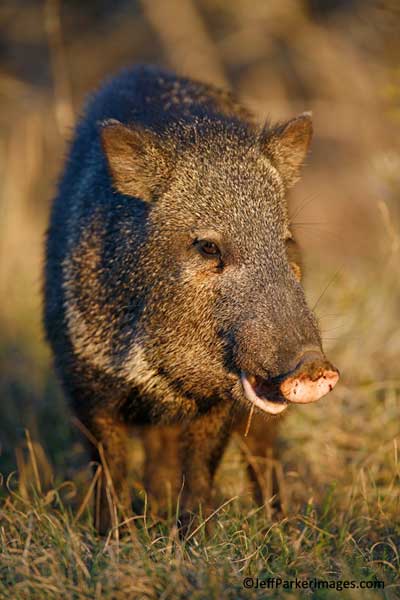
Having the advantage of living in javelina country, along with spending many field hours observing and photographing these creatures, I feel I have come to understand their behavior well.
THE FIRST TIP—what I consider to be the granddaddy of all wildlife photography tips: It is extremely important to understand your subject before heading out to photograph it.
So with that tip in mind, let’s begin by dispelling three myths about javelinas:
1. Javelinas are not pigs.
They’re actually collared peccary. Unfortunately, many people confuse javelinas with feral hogs, which gives rise to misconception #2.
2. Javelinas are not mean.
Javelinas have poor eyesight, and when startled, may accidently run toward you while attempting to flee. Or, they may stand their ground popping their jaws and raising the hair on their backs while trying to figure out what you are. Every reported javelina attack I verified (key word!) included a dog(s) and/or a javelina that had been fed by humans. Human injuries typically occurred when trying to break up a dog-javelina incident and/or attempting to pet or feed the wild animal.
3. Javelinas do not have tusks.
Their name comes from the Spanish word “jabalina” which means “spear” and refers to protruding canine teeth that look like tusks.
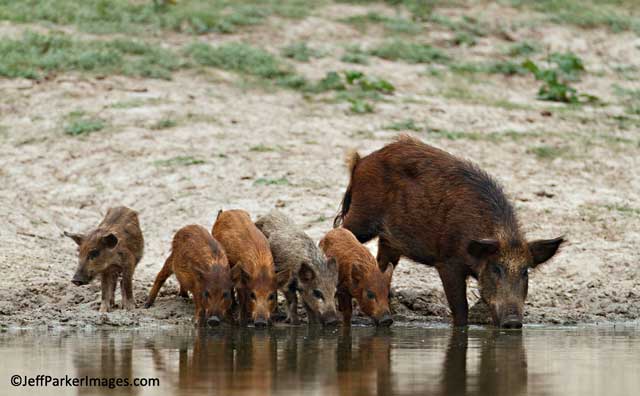
Feral hogs are true pigs, larger in size and have a different physical anatomy.
Okay, now that you know the subject a little better, let’s focus on photographing javelinas.
Best Places to Photograph Javelinas
Of the world’s three peccary species, you’ll find only javelina (collared peccary) in the United States. They inhabit the southern half of Texas, the Chihuahuan desert of west Texas and New Mexico, and the Arizona javelina (in Arizona’s Sonoran desert).
My favorite places to photograph javelinas are south-Texas’ photo-ranches, which have set-ups designed specifically for wildlife photography. Set-ups include photo-blinds (called “hides” in many places) with water features.
One javelina “sure spot” is Rio Grande Village Campground in Big Bend National Park where you’ll find them at dusk. Unfortunately, even with the National Park Service’s “no feeding wildlife” policy these animals get lots of free meals from campers, so you’ll have reliable photo subjects available. But please, do follow the parks “no feeding wildlife” policy.
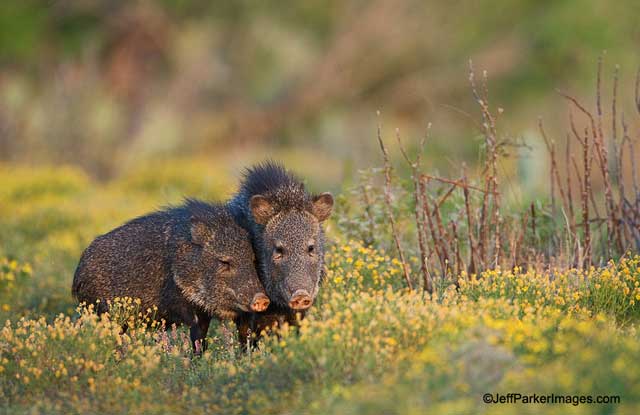
Javelina Love Nuzzle
for the Arizona javelina, try using a portable pop-up blind in the Catalina Mountains near Tucson or, for a great experience overall, you can visit Superstition Mountain. For additional photography adventures, head to New Mexico’s Big Hatchet Wildlife Management Area.
Look for javelinas in prickly pear flats and near mesquite trees (especially when the trees have beans). They travel in herds, so if you see one animal keep your eyes peeled for more.
Best Time of Year to Photograph Javelinas
You can photograph javelinas year-round, but I’d suggest skipping summer. Javelinas shed their very coarse hairs with the heat, which thins the defined ring near their shoulders (their “collar”). And the javelinas, although acclimated to the warm climate, become nocturnal as the brutal summer temperature rise.
Javelinas give birth any time of year. In Arizona breeding often peaks in late-winter with a lot of babies being born in the summer. But in south Texas you can find baby javelina amidst spring wildflowers.
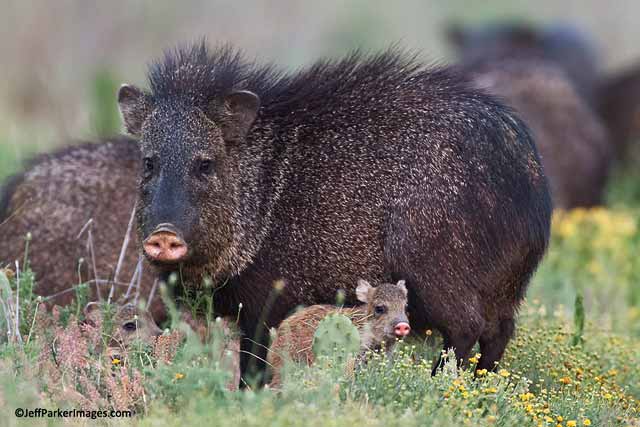
Mother Javelina with Her Young
Late-spring brings blossoming cactus. Since javelina hang out near prickly pear cactus no matter what time of year, photograph them in west Texas, Arizona, and New Mexico when the cactus bloom.
TIP: The background can be just as important as the subject, so consider what else your photographs will include when planning your photo adventure. For example, in south Texas, spring can be the best time to photograph javelinas. Given there’s been enough rain for wildflowers, all those colors help to create dramatic backgrounds.
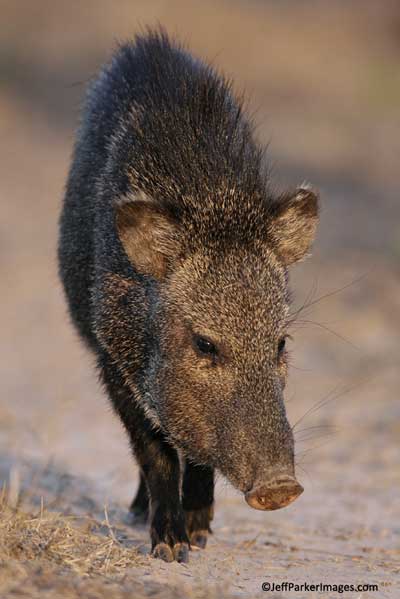
There’s the catch-light!
Best Time of Day to Photograph Javelinas
As with other wildlife, limiting hard shadows is important, so early and late in the day make the best times to photograph javelinas. That’s when the sun sits at a lower angle and shines less harshly because the light is traveling through a greater amount of atmosphere.
Thanks to the javelina’s facial structure, there are additional advantages. Their eyes are set deeply into their heads, which shields them from the harsh overhead sunlight. By working in early- and late-light, you’ll have a better chance of capturing that ever important catch-light in their eyes.
Best Types of Javelina Photographs
These animals have really interesting faces so portraits can “say” a lot. Make sure to photograph their faces from different angles. Like humans, javelina faces exhibit unique characteristics when photographed from different perspectives.
Animals in action and interacting with each other are the images we always seek! Javelinas make this task easier than with many other types of wildlife, because as herd animals, javelinas touch one another a lot.You don’t have to watch long to spot them nuzzling, nibbling, or nipping at one another. They also fight often, but usually in short spurts. So if you miss a quibble don’t worry—they’ll be at it again before long.
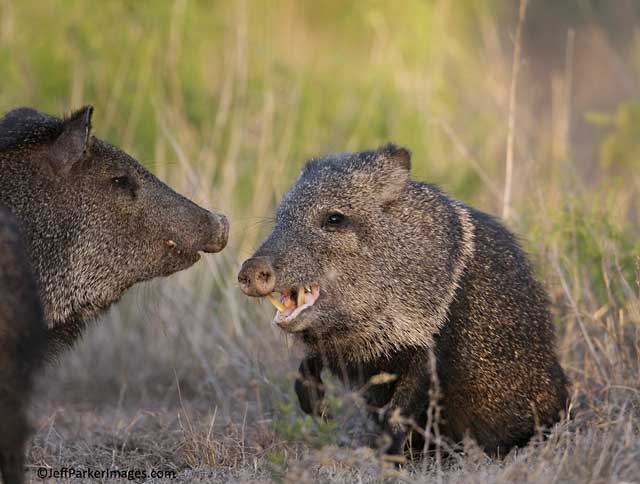
The Fight Begins – Need to Be Quick to Catch the Action
Consider including the surrounding landscape in your image compositions. To add interest and convey a larger environmental story, try focusing on groupings of odd numbers of animals hanging out near a prickly pear flat or in a field of wildflowers. Being able to show the “big picture” is icing on the cake!
Best Equipment to Use to Photograph Javelinas
A tripod and gimbal head greatly increase the number of keepers, so don’t leave home without them! It’s difficult to get great in-focus action shots without them.
Other equipment you’ll use depends upon how close you can get. Even with habituated peccary, I recommend at least a 300mm lens so as not to crowd them.
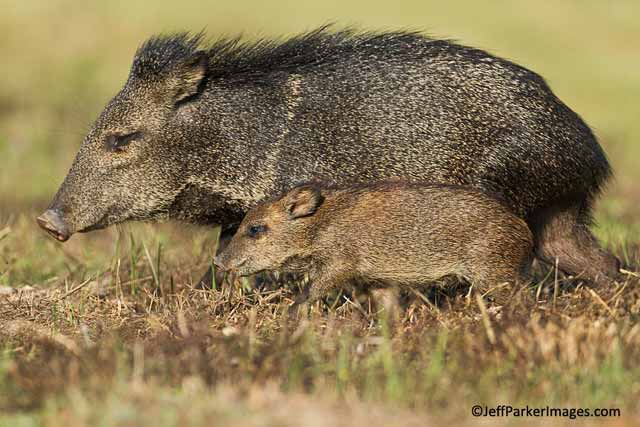
Not likely to make this image without a gimbal head on your tripod.
If you photograph from photo-blinds at south-Texas photo-ranches, a 500mm works perfectly. When photographing javelina in the field from a portable pop-up blind, I use my 600mm lens. Since wild javelina are not accustom to humans within their territory, I need a lens that lets me keep my distance.
In addition, when doing field work, keep a 100-400mm handy. You never know when a javelina (or two) might accidently stumble near (remember how poorly they see). In the wild, I’ve even had them come so close that I couldn’t get them in focus!
by Jeff Parker
All text & photos: © 2013 Jeff Parker Images. All rights reserved.

What do you think of the newer point and shoot cameras that have a power of 40x or more for doing photography like this. They also can get up close. If my math is correct it is a power for every 50 mm. That would make a 500 mm lens a power of 10 and the 600 just 12. They have pretty good f factors as well. Not as high as some cameras, but are they fast enough.